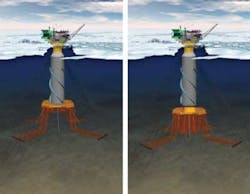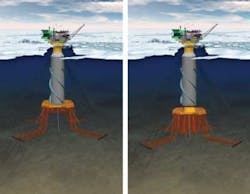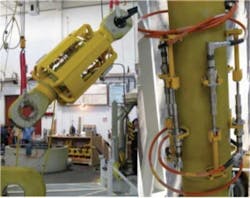Subsea intervention system for arctic and harsh weather
Alain Fidani, Gabriel Grenon - Cybernetix
Eric Rambaldi, Nicolas Tito - Total
Erich Luzi - Statoil
Swimmer is a new hybrid AUV/ROV subsea intervention system for light inspection, maintenance, and repair (IMR) operations on subsea production systems (SPS). One prime advantage is that it can carry out IMR operations on its own, without a field support vessel. Once the Swimmer AUV shuttle is resting on its docking station, the ROV can be controlled fully from surface facilities via the production control umbilical. The Swimmer’s technical feasibility was shown in 2001 by full-scale sea trials. Since 2007, Total, Statoil, and Cybernetix have cooperated to develop a commercial version.
Although the first application of this technology is earmarked for Total’s Angola block 17 in late 2011, the partners are investigating use of the Swimmer system in offshore fields with extreme weather conditions.
Swimmer not only can boost the flexibility and reduce the cost of operations for deep offshore fields, but also may become an enabling technology on ice-covered arctic fields or in harsh environments such as the North Sea. The weather at these fields can prevent intervention vessels from operating for long periods, and is a personnel safety concern. In these conditions, the Swimmer’s ability to remain deployed subsea for several consecutive weeks is a key point for the operability and maintenance of such fields.
For arctic regions, operations during ice formation and ice thickness may require an expensive icebreaker vessel. Drifting icebergs also threaten support vessels and production facilities. Sea state for some harsh environment areas may exceed Level 7 during parts of the year, making deployment and recovery of subsea intervention vehicles dangerous.
Swimmer can be a tool to operate and/or maintain subsea production assets when infrastructure is not reachable from the surface.
Swimmer concept
One prime advantage of swimmer is its capability to operate on its own, without a dedicated multiservice vessel (MSV). The AUV part of the hybrid vehicle, the so-called AUV shuttle, ideally is launched from surface production facilities or a vessel of opportunity, and programmed to navigate autonomously to a subsea docking station near the production equipment clusters.
Once the Swimmer AUV shuttle is on its docking station, the Swimmer ROV can be remotely controlled from the surface via the field control umbilical. The operator has the hand over of the Swimmer ROV just like for a conventionally MSV-deployed ROV. In this configuration, the Swimmer ROV is powered by the FPSO (or from shore), and intervention is performed conventionally with real-time data and video transmission.
The Swimmer can remain deployed subsea for several consecutive weeks.
Since the Swimmer performs all light IMR operations, the MSV can be dedicated to operations requiring handling of heavy equipment and modules. In this way, Swimmer introduces flexibility into the operations and reduces the overall opex.
The Swimmer concept was invented by Cybernetix in 1997. The feasibility of the concept was demonstrated successfully by Cybernetix and partners (IFREMER, the University of Liverpool) in October 2001 during full-scale sea trials.
The Swimmer AUV prototype was programmed to autonomously reach and securely land onto a docking station at 100 m (328 ft) water depth to tap energy and communication for the Swimmer ROV.
Following this demonstration, Cybernetix, with Statoil and Total, worked several cases to evaluate the economics of a Swimmer system for various fields. This work to a joint industry project (JIP) among the three partners to further study the technology. Phase 1 of the JIP showed the financial viability for future field developments, and recommended the extension of its scope of work to include pipeline survey and inspection.
In parallel, Cybernetix developed the Swimmer to a level of reliability required by the oil and gas industry. In particular, R&D efforts aimed at a robust and efficient docking algorithm, positioning and navigation systems, and subsea power and data transmissions.
More recently, Total and Cybernetix are targeting the development and qualification of a Swimmer system for offshore Angola block 17.
Main features
The Swimmer system is composed of both fixed and mobile assets. The fixed assets are part of the offshore field infrastructures and include the following:
- Subsea docking stations
- Subsea power and data cables embedded into the field control umbilical
- Control consoles integrated into the FPSO control room.
The hybrid vehicle and the associated IMR tools form the mobile assets and include the following:
- AUV shuttle
- Light Work-ROV equipped with two manipulator arms
- Work-ROV TMS integrated into the AUV shuttle
- ROV tools for light IMR operations.
The Swimmer is designed to stay deployed subsea for up to three months. The current design depth is 1,500 m (4,921 ft) but can be extended to 3,000 m (9,842 ft). The AUV shuttle operating range is 20 km (12 mi) in the standard configuration, but can be extended to 50 km (31 mi), and cruising speed is up to 2 knots. Once docked, the ROV excursion around the docking station is in the 200 m (656 ft) range.
The IMR tasks that can be performed by the Swimmer ROV include the following:
- 1. Valve operation
- 2. Cleaning
- 3. Global, close, and detailed visual inspection
- 4. Wall thickness measurement
- 5. Cathodic protection measurement
- 6. Support to electrical diagnosis and trouble shooting /fault finding
- 7. Assistance to large module replacement
- 8. Disconnection of lying leads
- 9. Fluid and thermal leak detection
- 10. Subsea sampling
- 11. Replacement of small components
- 12. Any other ROV operation requiring only the use of manipulators or manipulator carried tools.
The Swimmer AUV can be programmed for field survey and pipeline inspection tasks such as the following:
- 1. Field mapping
- 2. Pipeline survey
- 3. Pipeline close visual inspection
- 4. Pipeline free span detection
- 5. Pipeline localization
- 6. Dropped objects detection
- 7. Cathodic protection measurement.
The hybrid Swimmer vehicle combines ROV-borne IMR capabilities, suitable for maintaining SPS within tether range from the docking stations, with AUV-borne inspection capabilities for survey and inspection of subsea flowlines. Together, the scope of tasks covers the needs for all light IMR operations necessary to maintain a facility in production except replacement of large modules.
The tools for IMR tasks on an SPS are generally small and can be embarked directly by the light Work-ROV, or alternatively put into storage compartments onboard the AUV shuttle.
Some tools do not yet satisfy the requirements of the Swimmer system, particularly on long deployments. These include:
1. Tools requiring calibration (e.g. torque tool) prior to use. These calibrations currently are done at the surface. Because the Swimmer system can remain subsea for an extended duration, and because the calibration preferably should be performed just before the operation, and suitable marine-grade devices will be needed.
2. Seabed sampling is of interest for applications such as multiphase flow meter calibration, monitoring of oil-in-water and sand-in-water prior to reinjection, fiscal allocation, and reservoir monitoring for enhanced oil recovery programs.
3. Hydraulic tools are not ideal for long duration subsea use, so all-electric equivalents should be developed (e.g. torque tool, brush, manipulator).
Inspection of flowlines and cables, or general field survey, can be conducted from an AUV shuttle equipped with the guidance and data acquisition packages. The vehicle will autonomously follow its targeted path (e.g. a production flowline on the seabed), and record all relevant data on local storage devices for later analysis. After mission completion and return of the AUV to docking, data files are uploaded and the results analyzed offline. Because the operator is not in the loop during the survey, an AUV-based inspection is less reactive than with an ROV. However, its cost is lower and independent of the weather. Plus, the inspection may be repeated and modified for closer inspection if key points of interest were detected during the first survey.
The DP-2 surface vessel is the main cost of conventional IMR. A key of the Swimmer is that it only requires a surface vessel for launch and recovery. The vessel can be released after the AUV has docked subsea.
To further minimize MSV use and optimize opex, the Swimmer can remain operational subsea for up to three months at a time, without maintenance. This is achieved through careful hardware selection, and the implementation of multiple redundancies, fail-safe, and degraded mode layers throughout the system, such as redundant navigation sensors, communications, energy and electronics, fail-safe propulsion configurations, or redundant IMR tooling.
Further extending its operating endurance to six months will result from two combined processes. Feedback from operating the first Swimmer systems on remote fields will help develop operating methods to minimizing failures. Collaboration with SPS manufacturers will help increase operating reliability, through careful design of the interfaces between the SPS and the Swimmer ROV. Secondly, iterative engineering analysis will lead to the selection of upgraded hardware, and the implementation of additional layers of redundancy and degraded functionalities.
Sensitivity to surface conditions
Surface conditions, such as currents, waves and ice make deployment and recovery of an ROV uncertain, and risk harm to personnel and equipment, along with operating delays. Because the Swimmer is autonomous and hence untethered, launch and recovery may be done through a sequence of events decoupling the AUV from the ship.
Launch may use a deployment ramp at the aft of the ship. The vehicle slides on the ramp and into the water, while the support vessel is cruising forward, preventing collision between the two. Alternately, the AUV may be deployed by the MSV to the seafloor while attached to its deck cradle -- essentially a light version of a standard docking station -- then the AUV can release from the cradle and navigate to the production field. The deck cradle is recovered by the MSV.
Recovery of the Swimmer is initiated while it is on its docking station at the seabed. The surface vessel lowers the recovery apparatus attached to a crane or A-frame to the seafloor near the docking station. The Swimmer ROV captures the recovery apparatus, secures it to the AUV pad eyes on its top, and returns into the AUV. The AUV releases from the docking station and is hoisted to the surface as is done for standard ROVs. This eliminates most of the inherent risks of connecting a small marine vehicle to a larger one of a different dynamic behavior at sea.
Furthermore, AUV recovery is not time critical, and may be postponed if necessary.
In arctic areas, ocean surface formation of ice over subsea production fields can preclude operations, ultimately leading to IMR being interrupted or even worse, production facilities being shut down, until the ice recedes. Ice breakers may enable work, but with a significant price tag.
Swimmer may be deployed by a surface vessel away from the area of ice formation, move autonomously to its docking station near the subsea facilities, and then operate regardless of surface conditions. The onboard inertial navigation system will guide the AUV towards the target docking station, assisted with acoustic positioning relative to the docking station when within a few kilometers range.
When maintenance of the vehicle is needed, the vehicle will return autonomously to an ice-free area for recovery.
Finally, the Swimmer system can operate despite drifting icebergs. Apart from launch and recovery, all Swimmer operations are at 2 to 30 m (6.5 to 98 ft) above the seabed, and are remotely controlled by operators through a fast data link.
The Swimmer AUV can navigate as far as 50 km (31 mi) from its starting point using onboard lithium batteries. This usually is sufficient to reach any destination across a single production field, between neighboring fields, or to an ice-covered field after being deployed at the limit of the ice layer.
Yet higher ranges may be required, particularly if the vehicle must be fully autonomous from any surface support, and navigate on its own from the harbor to the production field, and back.
Increased autonomy can come by adding battery packs, but with a weight and size penalty, and also by improving hydrodynamic efficiency. Research is under way to improve the autonomy of lithium batteries and will further increase the range of AUVs.
An alternative for very long range (100 km [62 mi] and beyond) may be fuel cells. Already demonstrated on Jamstec’s Urashima AUV, and Kongsberg’s Hugin AUV, fuel cells may significantly increase energy storage onboard an AUV.
Integrated operations (IO), or e-fields, rely on fast data-rate networks to connect offshore facilities to onshore bases for real-time monitor and control. This does not provide for local maintenance. Swimmer can provide remote IMR capability, provided its docking stations (across multiple subsea fields) are connected to the IO networks. IMR operations then can be done remotely from the onshore base.






